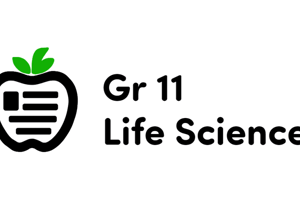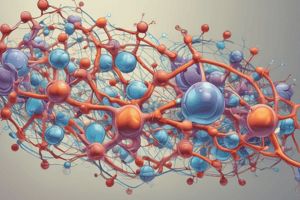Podcast
Questions and Answers
What is adenosine triphosphate (ATP) known as?
What is adenosine triphosphate (ATP) known as?
energy currency
What occurs when ATP is hydrolyzed?
What occurs when ATP is hydrolyzed?
Phosphate is removed and energy is released.
What must be the final state of energy as all energy is converted, according to the first law of thermodynamics?
What must be the final state of energy as all energy is converted, according to the first law of thermodynamics?
Heat
Why are the phosphates in ATP considered the source of usable potential energy?
Why are the phosphates in ATP considered the source of usable potential energy?
How can there be a decrease in free energy?
How can there be a decrease in free energy?
In which part of the mitochondrion is ATP synthase located?
In which part of the mitochondrion is ATP synthase located?
Which of the following statements is true about enzyme-catalyzed reactions?
Which of the following statements is true about enzyme-catalyzed reactions?
How can one increase the rate of a chemical reaction?
How can one increase the rate of a chemical reaction?
Approximately how many molecules of ATP are produced from the complete oxidation of two molecules of glucose during cellular respiration?
Approximately how many molecules of ATP are produced from the complete oxidation of two molecules of glucose during cellular respiration?
What are the products of the light reactions of photosynthesis that are subsequently used by the Calvin cycle?
What are the products of the light reactions of photosynthesis that are subsequently used by the Calvin cycle?
What group(s) is (are) always necessary in any ecosystem, terrestrial or aquatic?
What group(s) is (are) always necessary in any ecosystem, terrestrial or aquatic?
What wavelengths of visible light are absorbed by a plant's reddish-yellow photosynthetic pigment?
What wavelengths of visible light are absorbed by a plant's reddish-yellow photosynthetic pigment?
What will happen if a thylakoid is punctured so that its interior is no longer separated from the stroma?
What will happen if a thylakoid is punctured so that its interior is no longer separated from the stroma?
Reduction of oxygen which forms water occurs during respiration.
Reduction of oxygen which forms water occurs during respiration.
Describe the major components of the Gibbs Free Energy equation.
Describe the major components of the Gibbs Free Energy equation.
Explain how an increase in temperature can cause proteins to denature.
Explain how an increase in temperature can cause proteins to denature.
Explain the role of covalent and ionic bonds in ATP.
Explain the role of covalent and ionic bonds in ATP.
Which of the following is a true distinction between fermentation and cellular respiration?
Which of the following is a true distinction between fermentation and cellular respiration?
Where are the ATP synthase complexes located in a plant cell?
Where are the ATP synthase complexes located in a plant cell?
What best describes the relationship between photosynthesis and respiration?
What best describes the relationship between photosynthesis and respiration?
Flashcards are hidden until you start studying
Study Notes
ATP and Energy Coupling
- Adenosine Triphosphate (ATP) is the energy currency of cells, composed of adenine, ribose sugar, and three phosphate groups.
- ATP provides energy coupling between exergonic (energy-releasing) and endergonic (energy-consuming) reactions.
ATP Hydrolysis
- Hydrolysis of ATP removes a phosphate group, releasing energy and inorganic phosphate.
- The released inorganic phosphate can be added to other molecules, activating them for biochemical reactions.
Thermodynamics
- The first law of thermodynamics states that energy cannot be created or destroyed, only transformed.
- In energy reactions, some energy dissipates as heat, indicating that the final state of energy is often heat.
Phosphate Bonds
- The three negatively charged phosphates in ATP repel each other, creating high-energy covalent bonds.
- The repulsion between phosphates provides ATP with its usable potential energy.
Gibbs Free Energy
- The Gibbs Free Energy equation determines the spontaneity of reactions, indicating that a drop in free energy leads to spontaneous reactions and increased entropy.
- An increase in temperature can lower free energy in a system.
Enzyme Role
- Enzymes accelerate reactions, making them faster compared to the same reactions without enzymes.
- Catalysts can be added to increase the rate of chemical reactions.
Cellular Respiration and Energy Production
- Complete oxidation of two glucose molecules during cellular respiration produces approximately 76 ATP molecules.
- ATP synthase is located in the inner mitochondrial membrane, where ATP synthesis occurs.
Oxidative Phosphorylation
- The direct energy source driving ATP synthesis during oxidative phosphorylation is the difference in H+ ion concentrations across the inner mitochondrial membrane.
Fermentation vs. Cellular Respiration
- NADH is oxidized by the electron transport chain in cellular respiration, distinguishing it from fermentation processes.
Photosynthesis
- The light reactions of photosynthesis produce ATP and NADPH, which are essential for the Calvin cycle.
- A reddish-yellow pigment in a plant absorbs blue and violet wavelengths of visible light.
Ecosystem Function
- Autotrophs are essential in every ecosystem, both terrestrial and aquatic, as primary energy producers.
Thylakoid Integrity
- Damage to thylakoids that compromises their internal separation from the stroma directly impacts ATP synthesis.
Relationship Between Photosynthesis and Respiration
- Photosynthesis stores energy in organic molecules, while respiration releases that energy back into usable forms.
Water Formation in Respiration
- Reduction of oxygen to form water occurs during respiration, highlighting its role in cellular energy processes.
Gibbs Free Energy and Proteins
- The Gibbs Free Energy equation (ΔG = ΔH - TΔS) helps explain protein denaturation due to increased temperature leading to reduced free energy availability.
Bonds in ATP
- Covalent bonds in ATP store potential chemical energy, released when phosphate bonds break during cellular activities.
- Ionic bonds in molecules like NADP+ and NAD+ allow these electron carriers to transfer energy within cellular respiration.
Studying That Suits You
Use AI to generate personalized quizzes and flashcards to suit your learning preferences.



